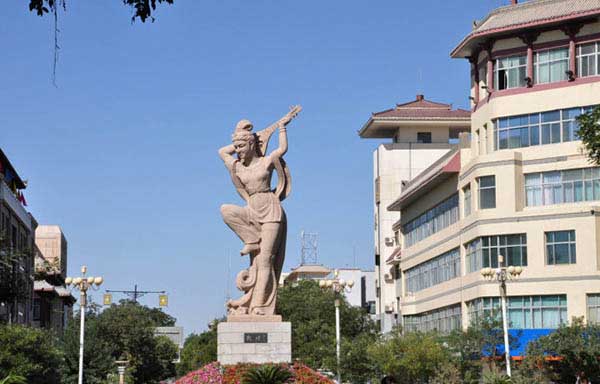- By admin
- In dunhuangknowledge
- 2016-05-14
The beginning of the Mogao Grottoes in dunhuang
Tales of the Buddhist caves at Sanwei Mountain spread far and wide. Where once the area was quiet and peaceful, it now bustled with joyful noise and excitement. People of every station and from all four prefectures of Wuwei, Zhangye, Jiuquan and Dunhuang came to the cliffs. There were aristocrats, government officials, rich merchants and commoners and a steady stream of Buddhists pilgrims, painters, stone masons and carpenters. They all came to help construct more caves.
From north to south along the whole cliff face, the air rang with the sounds of hammers and voices as layer upon layer of the sandstone was excavated. Over the next 1,000 years, hundreds of caves were carved out of the steep sandstone cliffs. For generations, pious women and men have continued to journey to the banks of the Great Spring at the foot of Sanwei and Singing Sands mountains to excavate and repair the grottoes at Mogao which, since Le Zun's vision, have become known as the Caves of the Thousand Buddhas
According to a Tang inscription, the Buddhist monk Le Zun, was inspired to create the first cave to house his vision of the Thousand Buddhas in the year 366. During the reign of Empress Wu Zetian of the Tang Dynasty, 618-907, the number of grottoes was increased to over 1,000.
Related destinations
Why Choose Us?
We are the top Silk Road tour operator based in Dunhuang, China. We focus on providing well designed Silk Road China Tours with resonable price and thoughtful service.
- Easy & carefree booking
- The best value
- Great travel experience
- Locally operated
Hot Tours
-

6 days Gansu tour to Binglingsi, Xiahe and Langmusi
Tour type : Private tour Price : from *** Destinations : Lanzhou - linxia - Xiahe - Langmusi - Hezuo - Lanzhou -

12 Days Gansu Highlights Tour
Tour type : Private tour Price : from *** Destinations : Xian – Tianshui – Lanzhou – Xiahe – Langmusi – Hezuo – Zhangye – Jiayuguan - Dunhuang -

10 Days Silk Road Classic Tour
Tour type : Private tour Price : from *** Destinations : Xian - Zhangye - Jiayuguan - Dunhuang - Turpan - Urumqi -

5 Days Zhangye - Alxa youqi Highlights Tour
Tour type : Private Tour Price : from *** Destinations : Zhangye - Alax youqi - Zhangye


